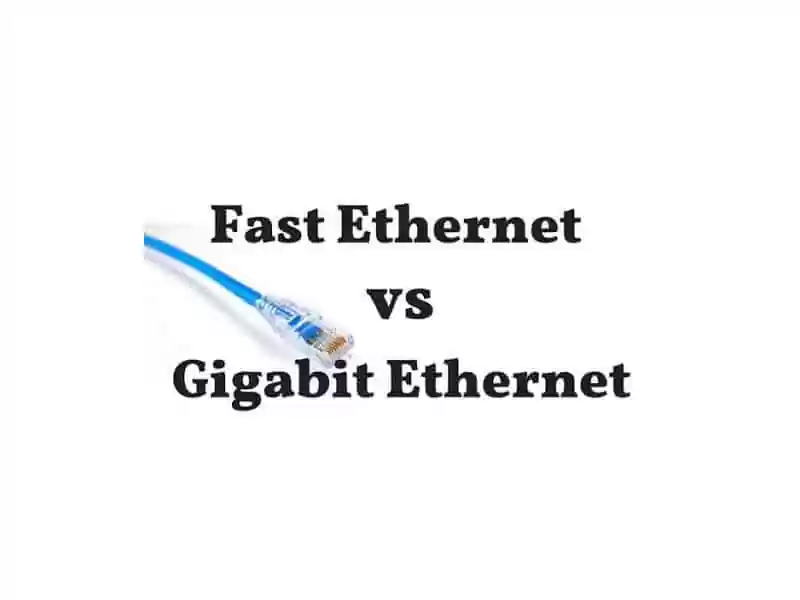Deciding between Fast Ethernet vs. Gigabit Ethernet may be challenging for many. However, the right choice can significantly enhance personal and business network performance.
The demand for faster, more reliable internet speeds continues to grow. Whether you’re streaming movies or managing a business with multiple networked devices, understanding the differences between these options is crucial.
This guide gives you the knowledge to make a practical decision that best suits your needs.
Understanding Ethernet Speeds
Network speed is crucial in today’s digital age. Faster speeds mean smoother streaming, quicker downloads, and more efficient business operations.
There are two primary speeds for wired network connections. Fast Ethernet offers speeds of up to 100 Mbps, and has been a reliable choice for many years. Gigabit Ethernet substantially upgrades, delivering speeds of up to 1000 Mbps.
As more devices become internet-dependent and data-heavy applications become commonplace, Ethernet speed becomes increasingly important.
3 Factors to Consider When Choosing Fast Ethernet Speed
When deciding between Fast and Gigabit Ethernet, there are several factors to consider:
- Current and Future Needs
The first step is to assess your current network usage. Consider how many devices are connected and what activities are taking place.
The first option might be sufficient for basic tasks like browsing the web. Yet, Gigabit Ethernet would be the better choice if you anticipate growth in the number of devices.
- Network Environment
The environment where the network will operate plays a critical role. Fast Ethernet switches might meet your needs in a small home network with limited devices.
However, in an office environment with multiple devices and users, Gigabit Ethernet ensures everyone experiences optimal performance.
- Budget
Budget considerations are also important. Hardware for the first option is generally less expensive. However, investing in Gigabit Ethernet can be more cost-effective in the long run, as it better accommodates future needs.
The choice of which Ethernet option to choose boils down to your needs and budget limitations.
Pros and Cons of Fast Ethernet
Advantages
- Cost-effective: The equipment is generally cheaper than Gigabit Ethernet.
- Sufficient for Basic Use: It is adequate for primary internet usage, including browsing, emailing, and low-definition streaming.
- Broad Compatibility: This type of Ethernet is compatible with various devices and older network infrastructure.
Disadvantages
- Limited Speed: The 100 Mbps speed limit may not suffice for high-bandwidth applications or future needs.
- Not Future-proof: As technology evolves, the limitations could necessitate an upgrade sooner than with Gigabit Ethernet.
Pros and Cons of Gigabit Ethernet
Advantages
- Higher Speed: With a fast ethernet speed of up to 1000 Mbps, Gigabit Ethernet supports high-definition streaming and online gaming.
- Future-proof: It can meet future applications’ demands and increase internet speeds.
- Better Multitasking: This option is ideal for environments with multiple high-demand devices and applications.
Disadvantages
- Higher Initial Cost: The equipment and installation costs are higher than those of other options.
- May Require New Cabling: In some cases, upgrading to Gigabit Ethernet may require Cat6 cabling, which will add to the setup cost.
Technical Considerations
Understanding the technical requirements is crucial when deciding between getting a Fast Ethernet switch vs. a Gigabit Switch.
Cable Types
- Fast: It typically uses Cat5 or Cat5e cables, which support speeds up to 100 Mbps.
- Gigabit: It requires Cat5e or Cat6 cables to achieve speeds up to 1000 Mbps.
Hardware Compatibility
The choice of routers and switches also impacts your network’s performance. For the first option, devices will limit the network speed to 100 Mbps. For Gigabit Ethernet, ensure all network devices are fully Gigabit-capable to benefit from the increased speed.
Some Applications and Examples
Understanding how Gigabit Ethernet vs. Fast Ethernet performs in real-world situations can help you make a practical decision.

Example Scenario 1: Small Business Upgrade
The growing graphic design studio owner, Sarah, established her office network with the first Ethernet option. This setup worked well when her team was small, and the projects were less demanding.
However, faster data transfers and reliable cloud storage access became critical as her business expanded. Upgrading to Gigabit Ethernet allowed Sarah’s team to handle larger files and collaborate on complex projects in real-time.
This upgrade from using a Fast Ethernet switch enhanced productivity and positioned her business for further growth.
Example Scenario 2: Home Network Enhancement
John, a casual internet user, primarily uses his home network to browse the web. The first Ethernet option has served him well, providing sufficient speed for his basic needs.
However, as his household adopted more smart devices, the limitations of this Ethernet option became apparent. Upgrading to Gigabit Ethernet improved the overall network performance, ensuring seamless streaming.

Choosing Your Ideal Speed
The choice between Fast Ethernet vs. Gigabit Ethernet ultimately depends on your personal or business needs.
At Westward Sales, we provide tailored solutions for your networking needs. Our experts are here to help you choose the ideal Ethernet speed. Contact us for personalized advice, and let us help optimize your network performance.

Leave a Reply